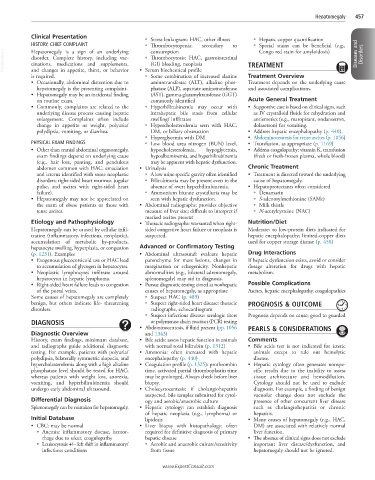Page 933 - Cote clinical veterinary advisor dogs and cats 4th
P. 933
Hepatomegaly 457
Clinical Presentation ○ Stress leukogram: HAC, other illness ○ Hepatic copper quantification
HISTORY, CHIEF COMPLAINT ○ Thrombocytopenia: secondary to ○ Special stains can be beneficial (e.g.,
VetBooks.ir disorder. Complete history, including vac- ○ Thrombocytosis: HAC, gastrointestinal TREATMENT Diseases and Disorders
consumption
Hepatomegaly is a sign of an underlying
Congo red stain for amyloidosis)
(GI) bleeding, neoplasia
cinations, medications and supplements,
and changes in appetite, thirst, or behavior
○ Some combination of increased alanine
is required. • Serum biochemical profile Treatment Overview
• Occasionally, abdominal distention due to aminotransferase (ALT), alkaline phos- Treatment depends on the underlying cause
hepatomegaly is the presenting complaint. phatase (ALP), aspartate aminotransferase and associated complications.
• Hepatomegaly may be an incidental finding (AST), gamma-glutamyltransferase (GGT)
on routine exam. commonly identified Acute General Treatment
• Commonly, complaints are related to the ○ Hyperbilirubinemia may occur with • Supportive care is based on clinical signs, such
underlying disease process causing hepatic intrahepatic bile stasis from cellular as IV crystalloid fluids for rehydration and
enlargement. Complaints often include swelling/ infiltrates antiemetics (e.g., maropitant, ondansetron,
change in appetite or weight, polyuria/ ○ Hypercholesterolemia seen with HAC, dolasetron) for vomiting.
polydipsia, vomiting, or diarrhea. DM, or biliary obstruction • Address hepatic encephalopathy (p. 440).
○ Hyperglycemia with DM • Abdominocentesis for tense ascites (p. 1056)
PHYSICAL EXAM FINDINGS ○ Low blood urea nitrogen (BUN) level, • Transfusion, as appropriate (p. 1169)
• Other than cranial abdominal organomegaly, hypocholesterolemia, hypoglycemia, • Address coagulopathy: vitamin K, transfusion
exam findings depend on underlying cause hypoalbuminemia, and hyperbilirubinemia (fresh or fresh-frozen plasma, whole blood)
(e.g., hair loss, panting, and pendulous may be apparent with hepatic dysfunction.
abdomen common with HAC; emaciation • Urinalysis Chronic Treatment
and icterus identified with some neoplastic ○ A low urine specific gravity often identified • Treatment is directed toward the underlying
disorders; right-sided heart murmur, jugular ○ Bilirubinuria may be present even in the cause of hepatomegaly.
pulse, and ascites with right-sided heart absence of overt hyperbilirubinemia. • Hepatoprotectants often considered
failure). ○ Ammonium biurate crystalluria may be ○ Denamarin
• Hepatomegaly may not be appreciated on seen with hepatic dysfunction. ○ S-adenosylmethionine (SAMe)
the exam of obese patients or those with • Abdominal radiographs: provides objective ○ Milk thistle
tense ascites. measure of liver size; difficult to interpret if ○ N-acetylcysteine (NAC)
marked ascites present
Etiology and Pathophysiology • Thoracic radiographs: warranted when right- Nutrition/Diet
Hepatomegaly can be caused by cellular infil- sided congestive heart failure or neoplasia is Moderate- to low-protein diets indicated for
tration (inflammatory, infectious, neoplastic), suspected. hepatic encephalopathy; limited-copper diets
accumulation of metabolic by-products, used for copper storage disease (p. 458)
hepatocyte swelling, hyperplasia, or congestion Advanced or Confirmatory Testing
(p. 1231). Examples • Abdominal ultrasound: evaluate hepatic Drug Interactions
• Exogenous glucocorticoid use or HAC lead parenchyma for mass lesions, changes in If hepatic dysfunction exists, avoid or consider
to accumulation of glycogen in hepatocytes. margination or echogenicity. Nonhepatic dosage alteration for drugs with hepatic
• Neoplastic lymphocytes infiltrate around abnormalities (e.g., bilateral adrenomegaly, metabolism.
hepatocytes in hepatic lymphoma. splenomegaly) may aid in diagnosis.
• Right-sided heart failure leads to congestion • Pursue diagnostic testing aimed at nonhepatic Possible Complications
of the portal veins. causes of hepatomegaly, as appropriate Ascites, hepatic encephalopathy, coagulopathies
Some causes of hepatomegaly are completely ○ Suspect HAC (p. 485)
benign, but others indicate life- threatening ○ Suspect right-sided heart disease: thoracic PROGNOSIS & OUTCOME
disorders. radiographs, echocardiogram
○ Suspect infectious disease: serologic titers Prognosis depends on cause; good to guarded
DIAGNOSIS or polymerase chain reaction (PCR) testing
• Abdominocentesis, if fluid present (pp. 1056 PEARLS & CONSIDERATIONS
Diagnostic Overview and 1343)
History, exam findings, minimum database, • Bile acids: assess hepatic function in animals Comments
and radiographs guide additional diagnostic with normal total bilirubin (p. 1312) • Bile acids test is not indicated for icteric
testing. For example, patients with polyuria/ • Ammonia: often increased with hepatic animals except to rule out hemolytic
polydipsia, bilaterally symmetric alopecia, and encephalopathy (p. 440) disease.
hypercholesterolemia along with a high alkaline • Coagulation profile (p. 1325): prothrombin • Hepatic cytology often generates nonspe-
phosphatase level should be tested for HAC; time, activated partial thromboplastin time cific results due to the inability to assess
whereas patients with weight loss, anorexia, may be prolonged. Always check before liver tissue architecture and hemodilution.
vomiting, and hyperbilirubinemia should biopsy. Cytology should not be used to exclude
undergo early abdominal ultrasound. • Cholecystocentesis: if cholangiohepatitis diagnosis. For example, a finding of benign
suspected, bile samples submitted for cytol- vacuolar change does not exclude the
Differential Diagnosis ogy and aerobic/anaerobic culture presence of other concurrent liver disease
Splenomegaly can be mistaken for hepatomegaly. • Hepatic cytology: can establish diagnosis such as cholangiohepatitis or chronic
of hepatic neoplasia (e.g., lymphoma) or hepatitis.
Initial Database lipidosis • Many causes of hepatomegaly (e.g., HAC,
• CBC: may be normal • Liver biopsy with histopathology: often DM) are associated with relatively normal
○ Anemia: inflammatory disease, hemor- required for definitive diagnosis of primary liver function.
rhage due to ulcer, coagulopathy hepatic disease • The absence of clinical signs does not exclude
○ Leukocytosis +/− left shift in inflammatory/ ○ Aerobic and anaerobic culture/sensitivity important liver disease/dysfunction, and
infectious conditions from tissue hepatomegaly should not be ignored.
www.ExpertConsult.com

